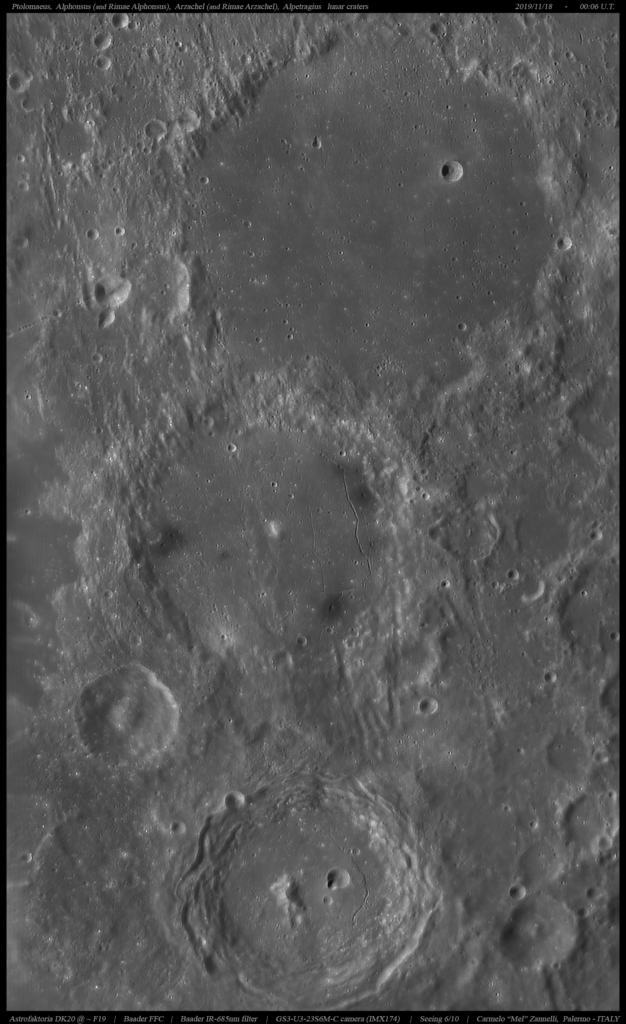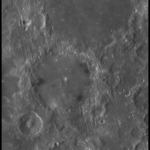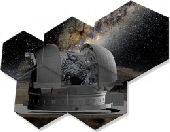Italiano:
Questa triade di crateri lunari, ripresa il 18 ottobre scorso in condizioni di alta illuminazione solare e seeing sufficiente nella prima sessione di riprese col nuovo strumento da 20″, è molto ben visibile anche con normali binocoli soprattutto subito dopo la fase di primo quarto lunare, quando l’inclinazione dei raggi solari mette in evidenza la loro formazione.
Il più grande dei tre, visibile in alto, è il cratere “Ptolomaeus” (Tolomeo), un antico cratere da impatto situato vicino al centro della faccia lunare a noi sempre visibile ed ha un diametro di circa 154 chilometri, con un bordo esterno basso e irregolare pesantemente usurato e colpito da molti crateri più piccoli. Il bordo ha una forma poligonale evidente, anche se nel complesso rimane circolare e il fondo del cratere un po’ scuro è notevole per la presenza di diversi crateri fantasma, formati dove la lava ha coperto un cratere preesistente.
Il cratere “Alphonsus”, al centro dell’immagine, ha un diametro di 119 km ed una profondità di 2,7 km e la sua forma è spezzata e irregolare lungo il suo confine col cratere Tolomeo.
Le pareti esterne sono leggermente distorte e possiedono una forma un po’ esagonale, inoltre il cratere è caratterizzato da un sistema a cresta bassa di rocce espulse dalla pressione dell’impatto meteorico (chiamate “ejecta”) che taglia in due il fondo del cratere e il picco centrale, a forma di piramide, sale ad un’altezza di 1,5 km sopra la superficie interna.
Il fondo del cratere è frastagliato da un elaborato sistema di fratture e contiene quattro o cinque crateri più piccoli circondati da un alone simmetrico più scuro.
Il terzo cratere, più piccolo dei tre ed in basso nell’immagine, è “Arzachel” con un diametro di 96 km. ed una profondità di 3,6 km. Esso ha una struttura facile da vedere a causa della sua struttura ad alti gradoni sui suoi bordi che, appunto per questo, è chiamato come cratere ad “anfiteatro”; Al centro è possibile vedere un’ejecta (montagna con struttura da eiezione) alta 1,5 km e, con un telescopio di media apertura, è anche possibile vedere dei solchi nel fondo del cratere, così come altri crateri più piccoli e giovani.
Grazie per la Vs. attenzione!
Dettagli tecnici:
Telescopio Astrofaktoria DK20 @ ~ F/19 – Baader FFC Multiplier – Baader IR 685nm filter – GS3-U323S6M-C camera – Seeing 6,5/10 in IR band – sito: Palermo @ my personal Observatory.
English:
This trio of lunar craters, shot in conditions of high solar illumination and fair seeing during the first light of my new 20″ scope (October – 18th), is very clearly visible even with normal binoculars especially immediately after the first quarter lunar phase, when the inclination of the solar rays highlights their formation.
The largest ofthe three, visible at the top, is the crater “Ptolomaeus”, an ancient impact crater located near the center of the lunar face and has a diameter of about 154 kilometers, with a low outer edge and irregular worn. The border has an evident polygonal shape, even if overall it remains circular and the bottom of the crater is a bit dark due to the presence of several phantom craters, formed where the lava has covered an existing crater.
The “Alphonsus” crater, in the center of the image, has a diameter of 119 km and a depth of 2.7 km and its shape is broken and irregular along its boundary with Ptolomaeus crater. The external walls are slightly distorted and possess a slightly hexagonal shape, furthermore the crater is characterized by a low crest system of rocks expelled by the pressure of the meteoric impact (called “ejecta”) which cuts the crater floor in two; the central peak, in the shape of a pyramid, rises to a height of 1.5 km above the inner surface.
The crater floor is fractured by an elaborate fracture system and contains four or five smaller craters surrounded by a darker symmetrical halo.
The third crater, smaller than the three and at the bottom of the image, is “Arzachel” with a diameter of 96 km. and a depth of 3.6 km. It has an easy structure to see due to its structure with high steps on its edges which, precisely for this reason, is called as “amphitheater” crater; In the center it is possible to see an ejecta of 1.5 km high, and with a medium objective-diameter telescope it is also possible to see furrows in the crater floor, as well as other smaller and younger craters.
Thank you for your attention!
Technical details:
Astrofaktoria DK20 telescope @ ~ F/19 – Baader FFC Multiplier – Baader IR 685nm filter – GS3-U323S6M-C camera – Seeing 6,5/10 in IR band – site: Palermo @ my personal Observatory.


